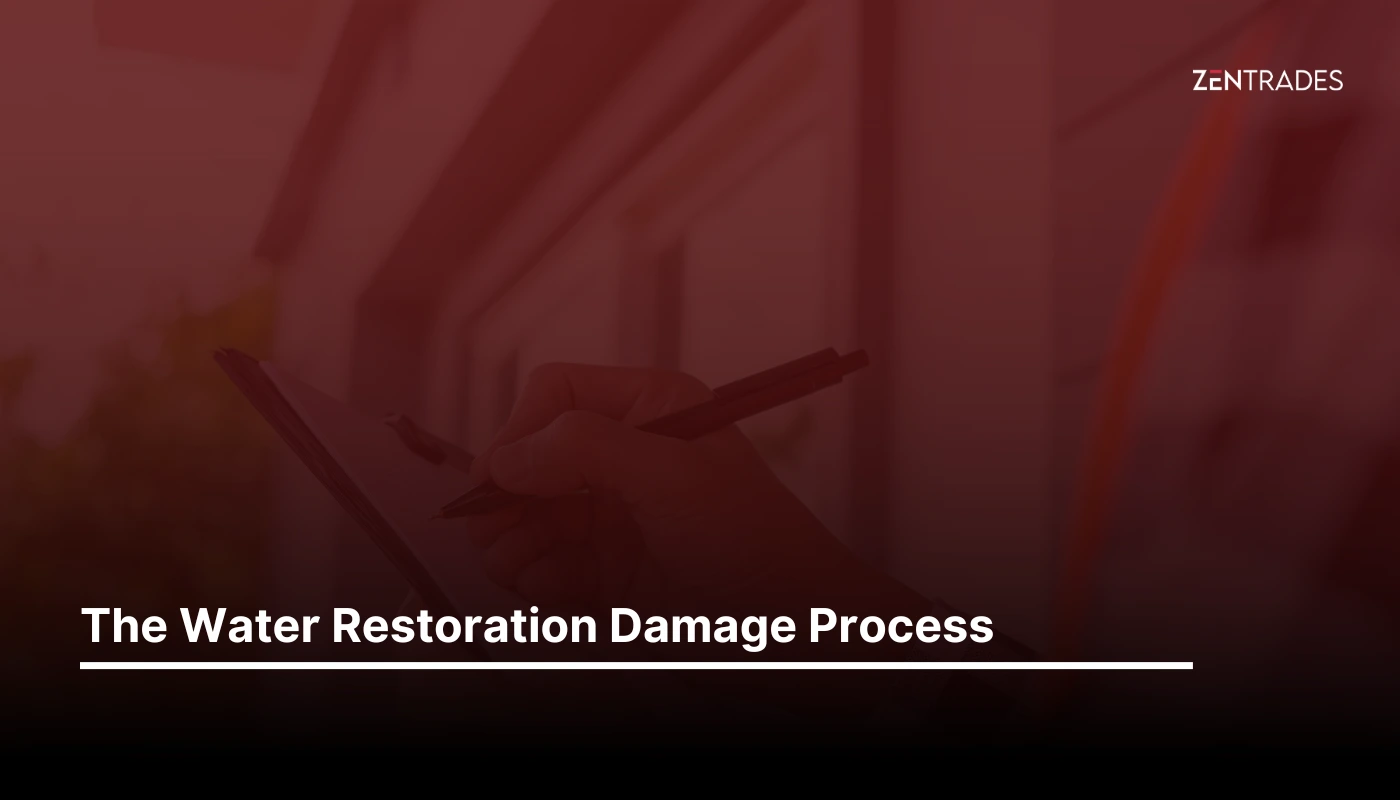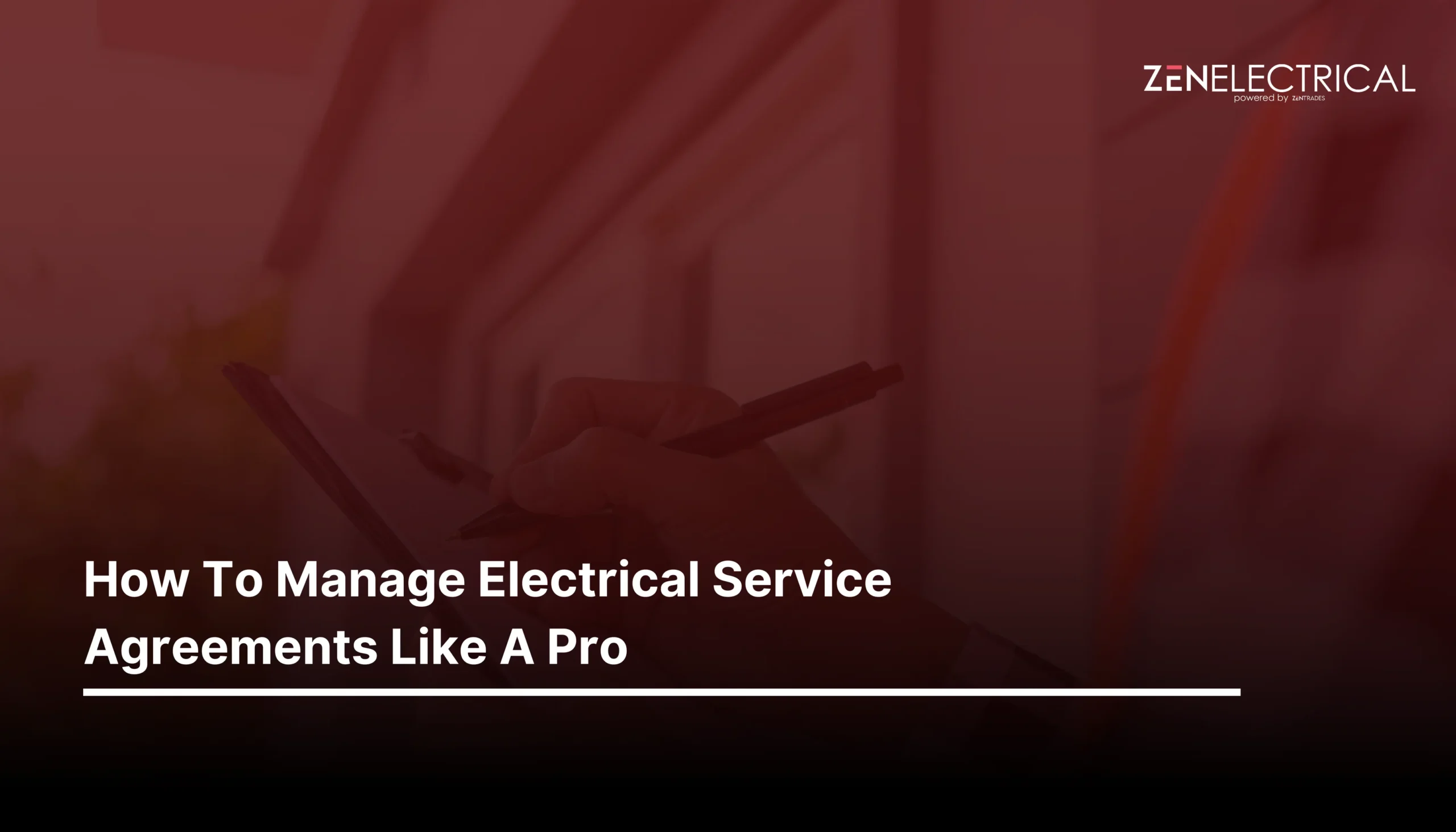The Water Damage Restoration Process
- Field Service Management
- 9 Min Read
Water damage is a frequent issue that most buildings face after some time and an issue that can prevail during events like natural disasters. Due to the unpredictable nature of this issue, the dependency on faster and more effective solutions that can be implemented in a short period is a significant pain point for the restoration industry.
Water damage restoration is restoring, repairing, and replacing components of structures and materials to their original form before the property was affected by the disaster that caused water damage.
Many professional companies today provide these services and so much more, which we will explore further in this article. This article will explore in depth what water damage restoration is, its steps, and how it can be implemented most efficiently to prevent significant losses and ensure the safety of an individual’s health against water damage.
Here What We Cover
What Is Water Restoration Damage, & Why Is It Essential?
When water intrudes upon a property in areas with building materials that are not protected against it, it can cause temporary and permanent damage to structures that can affect the safety of people within the property.
Water damage restoration involves technicians from a water damage restoration company handling the water problem and reversing the water’s effects on the building’s structures by returning them to their initial integrity and preventing further damage.
Anyone who knows what they’re doing can perform this process of restoration services. Still, it is preferred by certified professionals who have the proper knowledge and tools to execute the entire process without difficulty and the skill to ensure that the structure is returned to its original or more substantial state than before.
The entire process of water damage restoration involves five different integral steps,
- Inspection of the Problem
- Extraction of Water
- Dehumidification
- Sanitation
- Repair and Reconstruction
One of the main reasons why water damage restoration is deemed essential is its impact on a building’s structural integrity. Water may not seem like that big of a problem when it comes to building problems, especially when you have termites, pipes, fungus, rodent infestations, and more to compare to it. But, a common misconception this article aims to break is that water damage can be as deadly, even more so when you compare it to other building problems.
Water damage does not show as a problem immediately in any situation. It is an element that takes time to create problems, and if left untreated for too long, it can make difficulties permanent and untreatable. Water is one of the main reasons for structural damage and has the power to collapse ceilings, floors, and even walls.
Damage to building structures from water is often the beginning point of other problems within a building’s architecture. Problems like pest infestation, mold growth in between walls and through ventilation ducts, and bacteria buildup all start from leaving water damage untreated for too long. Hence, ignoring water damage as a minimal problem can endanger people’s lives and negatively affect their long-term health.
One advantage against water damage is that it can cause minimal damage to a structure if treated quickly. Therefore, when it comes to any situation related to water damage, speed is of the utmost importance to ensure that it does not have a permanent negative effect.

Use our free estimate template now
Make winning quotes in minutes—for any industry and any job.
What Are The Sources Of Water Damage?
Before being able to solve a water damage crisis, technicians need to figure out the source of the problem so that they can,
- Plug the current problem from the primary source instead of immediately cleaning up the damage as a temporary solution.
- Prevent any future problems from occurring from the same source, ensuring a part of the system is fully protected from water damage.
- Improving the conditioning of the source, more than the initial structural power it had before the water damage occurred.
For a restoration professional, it is helpful to know the frequent causes of water damage so that they can quickly identify a problem within the system and solve it much faster.
Here are a few telltale causes that every professional should know about,
Sewer Backups: Both sewers and septic tanks can become clogged or full and cause water to back up into a property. Excessive water usage and improper installation of septic tank systems can also cause this.
Faulty Water Heaters: Water heaters can have an internal problem or external corrosion, which can cause them to malfunction and cause slow or sudden water leaks.
Rain: Heavy rain and similar conditions like snow and hail storms can flood properties with water if proper water drainage systems are not installed on buildings and surrounding roads.
Clogged Drains: Drains clogged with human hair, plastic materials, toilet paper, and other solid agents can cause pressure buildup in water drain systems, breaking the system and causing water damage.
Natural Disasters: Unpredictable disasters like landslides, cyclones, tornados, earthquakes, and tsunamis can cause all types of damage to buildings and bring water into and onto properties at such fast speeds that can cause significant structural damage.
Sprinkler Systems: If not maintained regularly, your automatic sprinkler systems can cause water damage through bursts and malfunctions. Annual inspections of all your water-based protection systems are a must.
Rooftop Drainage: If properties do not have a proper system for rainwater drainage, ceilings can become wholly flooded, causing water damage to the top of the building and slowly influencing structures.
Water Supply Lines: Water supply lines for groups of buildings can get corroded and rusted if not maintained or placed in the wrong environment. This can cause water damage and more dangerous problems, like contaminated drinking water.
Toilet Overflow: Toilets clogged with materials that aren’t supposed to be flushed down the toilets, like plastics, can overflow from the water pressure and cause flooding of contaminated water.
AC Units: Air conditioning appliances have refrigerating agents that must be refilled occasionally. Not doing so can lead to the evaporator coil within the unit freezing up. Air filters that haven’t been cleaned in a while can also cause water damage from dripping water through the appliance’s drain pans.
Leaking Pipes: Leaking pipes due to physical damage or corrosion and burst pipes due to pressure buildup and clogging can cause significant water damage.
Sump Pumps: Basement sump pumps can malfunction due to clogging or rusting. This can prevent water from draining out of the basement, causing water damage and flooding.
Appliances: Dishwashers, washing machines, and refrigerators are all appliances that can have electrical and component problems. Some of these problems can cause leakages and cause water damage to surrounding areas.
Signs It’s Time For The Professionals To Take Over
After understanding some of the significant sources of water damage, another aspect of restoration jobs is finding the problems before they’ve grown out of hand. Restoration professionals have the proactive ability to sense water damage issues before they happen and ensure that they are controlled and repaired, if necessary, to avert any significant damages.
Here are a few signs that restoration technicians use to sense water damage before they create a permanent problem,
- Murky toilet water, gurgling noises from the drains, slowly draining sinks, and foul odors around the building indicate that your sewage system or connected septic tanks are clogged or full and must be repaired.
- If you see some pools of water around the water tanks and notice an unusually fast growth rate of your lawn, these are indicators of an underground pipe leak or a tank leakage.
- Visible structural damage directly indicates that water damage might be present under the layers of structures and needs to be examined.
- If you notice water stains on your walls or ceiling, a leak within the wall or ceiling structure must be fixed.
- Patches of mold in the corners of your walls and buildings indicate the presence of some unnecessary moisture that could’ve been caused by leakage or rainfall.
- When walking around, if you notice some somewhat uneasy smells like damp or musty odors, it is advised to try to find the source of this smell and check for any water damage in that area of the building.
- Cracks in building walls or ceilings indicate structural uneasiness that water leakages could have caused. Check the area with the cracks for damp parts or mold-smelling odors to indicate water damage.
- Random puddles of water appearing frequently in one spot in your building can indicate leaks unless they are next to open windows and the weather is dull lately.
- If you encounter materials or objects that have swollen or shrunk due to absorbing moisture, check the nearby surroundings for any water damage. This can include soft or saggy spots in your building’s walls, floors, or ceilings.
If the paint on building walls is peeling or bubbling off the wall, it can indicate internal water damage.
The Complete Water Damage Restoration Process
For a better understanding of the process, water damage professionals have divided the entire process of water damage restoration into five simple steps,
Inspection
Within conducting a water damage inspection, there are three final identifications that a water technician will take away from the inspection,
The Primary Water Source
- A water damage restoration professional must first identify the water source that caused the damage.
- Even after finding the actual cause of the damage, it may still be challenging to see the final water source that started the issue.
- Without finding the source of the problem, a professional cannot fully resolve the issue, so although it may take a reasonable amount of time, this is the primary objective before moving on to the next task.
The Water Damage Classes
The classes for water damage provide professionals with information about the total amount of water that they will have to take care of during the restoration job and the projected rate of evaporation of the water and other materials based on the total amount and the type of wet materials in the area of the problem.
There are four different types of water damage classes, explained below,
Class 4 – Speciality Situations
- This class of water damage losses includes severe structural damage caused by significant water events such as floods, cyclones, or tsunamis.
- As is known about natural disasters, this type of water damage classification can have substantial adverse effects on the health of a building’s structure and integrity.
- This type of classification usually involves a large amount of water and thus needs special care regarding the techniques used for drying the property.
- This water damage class includes materials that have a low level of porosity, like,
- Rocks
- Hardwood
- Crawlspaces
- Plaster
- Concrete
- The drying process for Class 4 water damage losses is lengthy and must be done with precision.
Class 3 – Materials With The Fastest Rate Of Evaporation
- This class of water damage losses can also cause severe structural damage to the entire building/property.
- The materials included in this class have the fastest evaporation rate for all water damage classifications.
- Burst pipes and water from collapsed ceilings are the major causes of most disasters in this class of water damage.
- Class 3 water damage losses should be dealt with immediately, or they can cause prolonged effects that cannot be repaired in a building’s structure.
- This water damage class includes materials that come from saturating areas, such as,
- Cushions
- Subfloors
- Insulation
- Carpet
- Walls
- Ceilings
- Mold and mildew are added effects of class 3 water damage if the problem is not resolved immediately. Letting materials like this grow on a property can create long-term health issues for individuals living there.
Class 2 – Materials With A Fast Rate Of Evaporation
- This class of water damage losses can affect entire rooms within a building by affecting water-absorbent materials within each room.
- The problem comes under this category when the whole room has been visibly affected by water damage.
- The rate of water evaporation is usually fast for the materials included in this classification, making it easier to implement quick solutions.
- Another indicator for this water damage classification is some water damage and spots along the walls of the rooms. These lengths of water usually only go up to an area of 24 inches from the floor.
- This water damage class includes materials that can become extremely wet and affect the health of the surroundings, like,
- Furniture like Sofas and Chairs
- Carpets
- Materials made of absorbent wood (grainy)
- Flooring Boards
- Absorbent Cloths
- Class 2 water damage costs more than Class 1 because of the total area affected in this classification.
- The materials included in this category can prove difficult to clean and return to their original state, which may also increase some pricing levels.
Class 1 – Materials With A Slow Rate Of Evaporation
- This class of water damage losses only affects certain portions of a room within buildings and does not extend to the whole area of the premises.
- Out of all classifications, this water damage class is comparably the easiest to handle as the affected area or problem does not extend past a part of a room.z
- This class of damage creates minor water damage to the property, generally costing a very small amount to remedy.
- The items involved in the classification do not absorb much water, making it easier for professionals to bring the materials back to their original state.
- These materials have a low level of porosity and permeance to water, which can include,
- Structural Absorbent Wood
- Vinyl Tiles
- Particle Boards
- Concrete
- Plywood
- The cost of repair and replacement (if deemed necessary) is also the lowest for this classification, making it an easy problem to fix.
The Water Contamination Categories
Water damage is caused by the force and quantity of water that affects a property, but the type of water quality also matters. This can influence the damage it can have on building structures, the condition of materials within a building, and the permanent effect on the health of the people within the building.
The Institute of Inspection, Cleaning, and Restoration Certification (IICRC) has suggested three different water contamination levels, each divided by the severity of the water condition and its adverse effects on the health of affected citizens.
The American National Standards Institute (ANSI) or the IICRC S500 standard describes the complete procedures and the cautions to take care of before and during performing water damage restoration in any building.
The basis of the division of contaminated water by the IICRC considers both the starting source of the water damage problem and the quality change of the water after it comes in contact with other materials around the building or property.
The three different divisions of contaminated water levels are,
Sanitary Clean Water
- The IICRC defines the first category of water damage as water originating from any sanitary water source.
- If exposed, water damage of this category and kind should not pose a significant threat or risk to a citizen’s health.
- Since the water in this category is a healthier variant and not contaminated, it has no external effects from inhalation, ingestion, or dermal (skin) exposure.
- A few examples of safe and sanitary water damage sources that come under this category are,
- Melted Snow
- Rain
- Water Supply Lines
- Toilet Tanks
- In this category, it is generally possible to salvage materials that have been affected by water damage because they do not have any external effects, but this can heavily depend on the damage class.
Greatly Contaminated Grey Water
- The IICRC defines the second category of water damage as water that contains a large amount of contamination and is not a safe water source.
- This water damage and its source have the potential to cause significant discomfort and adversely affect a person’s health.
- This water source can harm a citizen’s health through contact with it, inhalation of harmful gases, or unknown consumption.
- Here are a few examples of water sources that are included in the second category,
- Punctured Water Beds
- Seepage Due To Hydrostatic Pressure From Pipes
- Overflow From Washing Machines
- Dishwasher Contamined Leakage
- Overflow Of Urine Water From Toilet Bowls
- Aquarium Water Leakage
- The water damage restoration process should include disinfectants to ensure that the materials affected by the water damage should be treated.
Heavily Contaminated Black Water
- The IICRC defines the third category of water damage as water that is heavily contaminated and unsafe to go near such a water source.
- This type of water source and damage can contain harmful agents like pathogens and toxins.
- Any physical contact, slight inhalation of gases from this body of water, or unintentional consumption of water from the source can have lasting adverse effects on a person’s health, like viruses and diseases, promoting a high probability of even death from exposure.
- Here are some examples of water damage sources included in this category and to stay away from for the benefit of your health,
- Seawater
- Rain from Hurricanes or Storms
- Rising Stream and River Water
- Sewage Water
- Waste Water Line Backflows
The materials affected by this type of water damage should be disposed of safely by professionals and replaced immediately. Salvaging is not an option for this type of water damage.
Extraction of Water
- Extracting water that has been contaminated and stagnant for a while is a crucial step before moving on to the next step in the restoration process.
- Standing water can continue to create problems like infections and permanently damage materials immersed in it for too long in its present environment.
- Vacuums and immersible pumps extract water from the area without directly contacting the contaminated water if it has been affected by harmful contaminants. These vacuums are industrial-level equipment and do not include regular cleaning vacuums.
- When all the stagnant water has been extracted in the water removal process, professionals start working on removing the surface water to make the area entirely water-free.
- Surface water is removed using portable dry or wet vacuums during water extraction, although removing all surface water with only just vacuums can be challenging.
- Hidden pockets of water buildup are familiar with water damage because water can get anywhere. These water pockets can be behind walls or even under the floorboards of the building.
Professionals use tools like infrared cameras, thermal imaging cameras, and moisture meters to find hidden patches of water. These tools make it easier to find patches that are not visible to the eye.
Get posts like this in your inbox.
Keep learning how to run a 5-star business with our bi-weekly newsletter.
Dehumidification
- The next step in the restoration process is to remove any traces of water altogether using dehumidification and drying techniques.
- One technique that professionals use to start this process is using heavy-duty fans and air movers to dry the affected areas.
- For higher-class water damages, professionals use commercial-grade equipment, such as mechanical dehumidifiers, to dry the area of any contaminated water.
- Removing moisture from an area can be difficult, no matter how much technology is used in these processes.
- Professionals implement natural methods like opening windows and doors to increase air circulation within the building, automatically dehumidifying the area, and removing any traces of harmful gasses.
- Demudification is generally a longer process than water removal because many factors must be considered before confirming complete dryness within an area.
This process will especially take longer if the water damage is of a higher class, like the 3rd or 4th classification, because these classifications would require removing floors and walls to reach all the patches of water.
Sanitation
The next step of the restoration process is to clean and sanitize the surfaces of the affected buildings and properties.
- This includes removing all traces of external particles (mold) that may have grown or accelerated in growth due to the water damage.
- Before starting these processes, professionals must ensure they are safe from exposure to the materials they remove from the affected surfaces.
- Professionals must wear personal protective equipment, such as goggles, biohazard suits, protective and disposable overalls, masks, rubber boots, gloves, and other equipment that can protect them from exposure.
- For the actual sanitation and cleaning processes, professionals use negative air machines to sanitize the environment, killing bacteria, germs, and viruses that can cause long-term health problems.
- If necessary, the professionals use equipment like High-Efficiency Particulate Air (HEPA) vacuums and air scrubbers to efficiently carry out the sanitation processes.
- This includes removing all traces of external particles (mold) that may have grown or accelerated in growth due to the water damage.
Removal, Repair, and Reconstruction
- The final step in the water damage restoration process is repairing the affected components in a property and reconstructing fundamental structures to reestablish the integrity of a building.
- This includes removing components professionals know cannot be salvaged or repaired to their original strength, such as carpet padding, drywall below the flood line, and trim boards.
- Carpets and rugs can be deep cleaned, but the probability of replacing them altogether is also high.
- Both trim boards and drywalls can also be salvaged and repaired if the water damage is not too much. Either a Class Four or Category Three is a definite replacement because of the repercussions that it can have on a person’s health.
Reconstruction is a significant possibility for water damage caused by natural disasters due to the level of physical damage that it can create.
Water Damage Restoration: A Necessity
The water damage restoration process can be lengthy and challenging to implement, even for professionals with plenty of experience. The process is integral to maintaining the strength of building structures and ensuring the safety of citizens.
One not-that-prominent advantage of water damage restoration is actually water damage itself. Professionals who know the restoration process understand that when you do water damage restoration, you bring the components back to their original state and improve upon what was present, better protecting them against any damage.
Therefore, if water damage happens again, a person does not have to spend as much or not have to spend at all because their building structures and materials are protected against it. The process, therefore, is the restoration of your building and an upgrade to its security.
For more information about water damage restoration and software that has exponentially improved the entire restoration process, check out another blog about the top water damage restoration software that businesses should use for their water restoration businesses.

Explore a better way to grow your business. Book a free demo now!
Get organized, win jobs, and wow customers.
Book A Free Demo with ZenTrades Today!
Related Reading
Why Your Field Software Management Software Needs QuickBooks Integration
ZenTrades Why Your Field Service Management Software Needs QuickBooks Integration Read More Request Demo...
Read MoreZenTrades How To Manage Electrical Service Agreements Like...
Read MoreZenTrades The Best 5 Jobber Alternatives In 2023...
Read More


